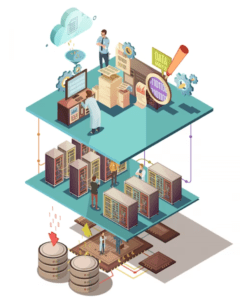The concept of Serverless Architecture is becoming popular among businesses of all sizes. In traditional practices, developers are responsible for maintaining servers and managing the load which is very time-consuming. In cloud computing for developers, the serverless architecture allows developers to focus on deploying applications and writing code rather than worrying about server management.
Serverless architecture works on the principle of Function as a Service (FaaS) where each function is responsible for a specific task. The real magic happens when this architecture is combined with cloud services like AWS, Google Cloud, and Microsoft Azure.
In this article, every aspect of building a serverless architecture will be covered. From designing functions to deploying them, from triggering and scaling to integrating with other cloud services, we will cover it all.
Understanding Serverless Architecture | Cloud Computing for Developers

Serverless architecture refers to the utilization of cloud infrastructure services rather than physical infrastructure. It revolves around focusing on writing code and deploying functions that perform specific tasks. These tasks include automating scaling and event-driven executions.
Cloud computing for developers has many benefits. Benefits of cloud infrastructure services include reduced operation overhead, cost efficiency, flexibility, low latency, and seamless scalability. Serverless architecture is used for cloud-based web development, fast data processing, real-time streaming, and IoT.
Choosing the Right Cloud Provider
The very first step towards building a serverless architecture is to choose a suitable cloud infrastructure service for your operations. In this critical step, you will encounter three giants: AWS Lambda, Azure Functions, and Google Cloud functions. Each of these cloud infrastructure services has a unique set of features. You can choose one based on your needs. You should consider the following factors when choosing a cloud platform.

Pricing Model: First of all you should decide whether you want a “pay as you go” model or a fixed subscription plan. AWS Lambda and Azure Function have a “pay as you go” model while Google Cloud Function has a subscription plan. Choose the service based on your budget.
Performance: Evaluate the performance of each provider. AWS Lambda boasts a quick start-up time, Google Cloud function is best for event-based executions, and Azure can handle large-scale applications with ease. Understand your needs and select according to your requirements.
Ecosystem Maturity: You should also consider the availability of other features. For example, AWS Lambda has its ecosystem of services while google cloud function has its own. Choose the provider based on your compatibility with the overall model.
Lastly, you should also consider vendor lock-in and compatibility with new technologies like Artificial Intelligence (AI) and Machine Learning (ML).
The process of choosing a cloud provider becomes easier with Nife, a cloud computing platform that provides flexible pricing, high performance, security, and a mature ecosystem. It eliminates the hassle of managing different provider-specific interfaces and allows developers to focus on building their applications without worrying about the underlying infrastructure.
Designing Functions for Serverless Architecture
Designing functions for serverless architecture requires careful consideration of responsibilities. Each function should be designed to perform an independent task. Complex applications should be divided into smaller ones for better management. Independent functions enable better scalability and maintainability. Here are two essential practices for designing functions for serverless architecture.
Single Responsibility Principle: Each function should be responsible for a single task. Complex functions should be divided into smaller focused functions. This practice keeps the codebase clean, easier to maintain, and makes debugging easier.
Stateless Functions: In serverless architecture functions should not rely on stored data or previous. Instead, data should be passed as input parameters from external sources like APIs. This allows for better scalability options.
By following these principles you can get many benefits that include improved cloud infrastructure development, agility, reduced operational overhead, and scalability. You can also move your application to Nife, a cloud computing platform that simplifies function design in cloud infrastructure development.
With Nife, developers can seamlessly integrate and manage their function designs. Nife provides a user-friendly environment for developers to deploy their cloud applications.
Developing and Deploying Functions
Developing and deploying functions in a serverless architecture is a streamlined process. Have a look at the step-by-step process, from setting up a cloud infrastructure development environment to packing and deploying your function to the cloud.
Setting up a Cloud Infrastructure Development Environment
Firstly you need to create your cloud infrastructure development environment to get started. Most cloud services provide the necessary tools and services to help you get started. You can install command line interfaces (CLIs) and development kita. You can then start creating, testing, and deploying functions.
Writing Code:

Cloud platform supports different languages like Python, Java, C++, and more. Select the language of your choice on your cloud platform and get started with writing your function.
Packing and Deploying Functions:
In cloud-based web development, it is crucial to test every function with different input scenarios. Validate the result from each test to catch any errors. Once the testing phase is completed. It’s time for packing and deployment. Utilize tools and other resources provided by your chosen cloud provider to deploy the functions.
You can also use version control and CI/CD to automate your deployment and development process.
Integrating with Other Cloud Services

In serverless architecture, you can seamlessly integrate with other services provided by the provider of your choice. Cloud computing for developers provides different services that include databases, storage, authentication, and many more.
By integrating with all these services you can store and process data, manage files, send notifications, enhance security, and increase efficiency. Integration can also elevate your cloud-based web development projects so you can create interconnected applications.
Take advantage of Nife’s comprehensive cloud computing platform for developers, where you can seamlessly deploy cloud services and unleash the true potential of your cloud-based web development projects.
Experience the power of cloud computing for developers with Nife and revolutionize the way you build, manage, scale, and deploy applications.
Build Your Serverless Architecture with Nife Today
Conclusion:
In conclusion, serverless architecture has revolutionized the development process in cloud computing for developers. By leveraging cloud services like AWS Lambda, Azure Functions, or Google Cloud Functions, developers can build scalable and cost-effective applications.
Developers can also leverage Nife, a cloud computing platform, that offers a comprehensive solution for developers seeking to embrace serverless architecture. With Nife, developers can streamline deployment and monitor services efficiently. With Nife build, deploy, manage, and scale applications securely and efficiently.






